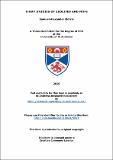Files in this item
X-ray studies of zeolites and MOFs
Item metadata
| dc.contributor.advisor | Morris, Russell Edward | |
| dc.contributor.author | Morris, Samuel Alexander | |
| dc.coverage.spatial | xii, 185 p. | en_US |
| dc.date.accessioned | 2016-11-28T16:11:11Z | |
| dc.date.available | 2016-11-28T16:11:11Z | |
| dc.date.issued | 2016-11-30 | |
| dc.identifier.uri | https://hdl.handle.net/10023/9891 | |
| dc.description.abstract | This thesis is largely a study of the ADOR process (assembly-disassembly-organisation-reassembly) when applied to zeolite UTL. The final chapter of this thesis deals with the adsorption of the medical gases NO and CO onto the metal organic framework NiNaSIP. Chapter 4 is devoted to the disassembly and organisation steps of the ADOR process. Calcined UTL was hydrolysed using 0.1 – 12 M HCl solutions from 75 – 95 °C run over 10 mins to 72 hrs. A three step mechanism is proposed, which is comprised of an initial rapid hydrolysis that removes the majority of the interlayer constituents of UTL, causing the silica-rich layers to largely collapse. This is followed by a slow, temperature and molarity dependent, deintercalation process that sees the remainder of the interlayer material removed resulting in the full collapse of the layers to form IPC-1P. The third step is a temperature and molarity dependent rebuilding process, whereby the interlayer region is slowly rebuilt, eventually forming a precursor which upon calcination becomes IPC-2 (OKO). Chapter 5 uses the pair distribution function (PDF) technique to structurally confirm the intermediate of the ADORable zeolite UTL. The intermediate, IPC-1P, is a disordered layered compound formed by the hydrolysis of UTL in 0.1 M HCl. Its structure is unsolvable by traditional X-ray diffraction techniques. The PDF technique was first benchmarked against high-quality synchrotron Rietveld refinements of IPC-2 (OKO) and IPC-4 (PCR) – two end products of IPC-1P condensation that share very similar structural features. An IPC-1P starting model derived from density functional theory was used for the PDF refinement, which yielded a final fit of Rw = 18% and a geometrically reasonable structure. This confirms that the layers do stay intact throughout the ADOR process, and shows that PDF is a viable technique for layered zeolite structure determination. Chapter 6 examines the reassembly stage by following the in-situ calcination of a variety of hydrolysed intermediates into their three-dimensional counterparts. Beamline I11 at Diamond Light Source provided high-quality PXRD patterns as a function of temperature, which were refined against using sequential Pawley refinements to track the unit cell changes. 0.1, 1.75, 2.5 and 12 M hydrolysed lamellar precursor phases were calcined. The largest unit cell changes were observed for 0.1 M, and the smallest for 12 M. This shows that increasing the molarity must prebuild most of the interlayer connections, such that upon calcination, only minimal condensation occurs to fully connect the layers. Chapter 7 probes the uptake of the medical gases CO and NO into the metal organic framework NiNaSIP. An in-situ single-crystal XRD study was undertaken using an environmental gas cell at beamline 11.3.1 at the Advanced Light Source. NiNaSIP was first dehydrated to reveal an open nickel site, which acted as the main site of adsorption for the inputted gases. NO was observed in a bent geometry at an occupancy of 40 % and a Ni – N bond length of 2.166(16) Å. The oxygen was modelled to be disordered over two sites. CO was not fully observed, as only the carbon was able to be modelled with an occupancy of 31.2 % and a Ni – C bond length of 2.27(3) Å. | en_US |
| dc.language.iso | en | en_US |
| dc.publisher | University of St Andrews | |
| dc.rights | Attribution-NonCommercial-NoDerivatives 4.0 International | * |
| dc.rights.uri | http://creativecommons.org/licenses/by-nc-nd/4.0/ | * |
| dc.subject | X-ray | en_US |
| dc.subject | X-ray diffraction | en_US |
| dc.subject | Zeolite | en_US |
| dc.subject | Zeolites | en_US |
| dc.subject | Metal organic frameworks | en_US |
| dc.subject | MOFs | en_US |
| dc.subject | Synchrotron | en_US |
| dc.subject | Diamond Light Source | en_US |
| dc.subject | Advanced light source | en_US |
| dc.subject | ADORable | en_US |
| dc.subject | ADOR process | en_US |
| dc.subject | NiNaSIP | en_US |
| dc.subject | UTL | en_US |
| dc.subject | Pair distribution function | en_US |
| dc.subject | Calcination | en_US |
| dc.subject.lcc | QD882.M7 | |
| dc.subject.lcsh | Zeolites | en |
| dc.subject.lcsh | Supramolecular organometallic chemistry | en |
| dc.subject.lcsh | X-rays--Diffraction | en |
| dc.title | X-ray studies of zeolites and MOFs | en_US |
| dc.type | Thesis | en_US |
| dc.contributor.sponsor | Engineering and Physical Sciences Research Council (EPSRC) | en_US |
| dc.type.qualificationlevel | Doctoral | en_US |
| dc.type.qualificationname | PhD Doctor of Philosophy | en_US |
| dc.publisher.institution | The University of St Andrews | en_US |
The following licence files are associated with this item:
This item appears in the following Collection(s)
Except where otherwise noted within the work, this item's licence for re-use is described as Attribution-NonCommercial-NoDerivatives 4.0 International
Items in the St Andrews Research Repository are protected by copyright, with all rights reserved, unless otherwise indicated.


